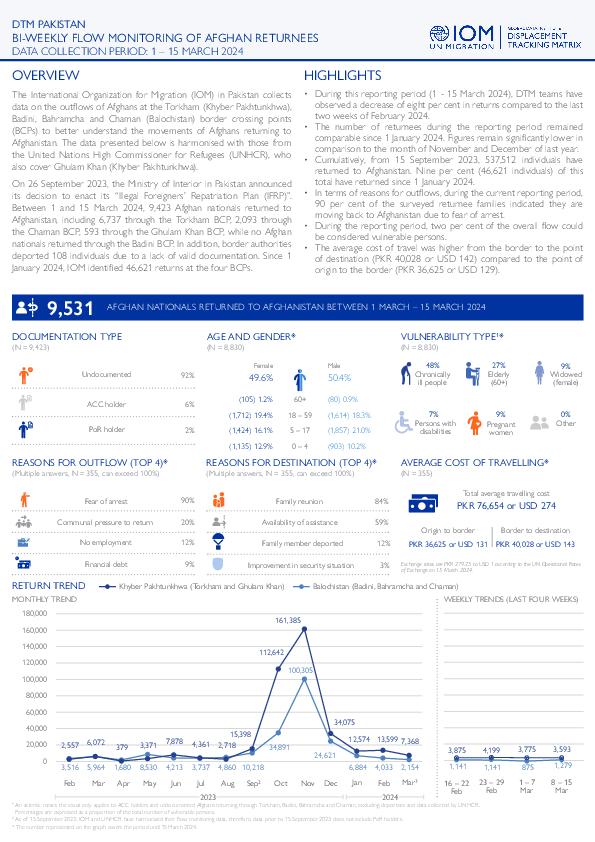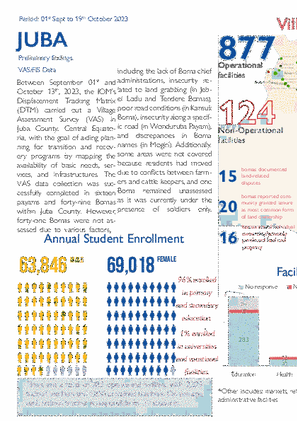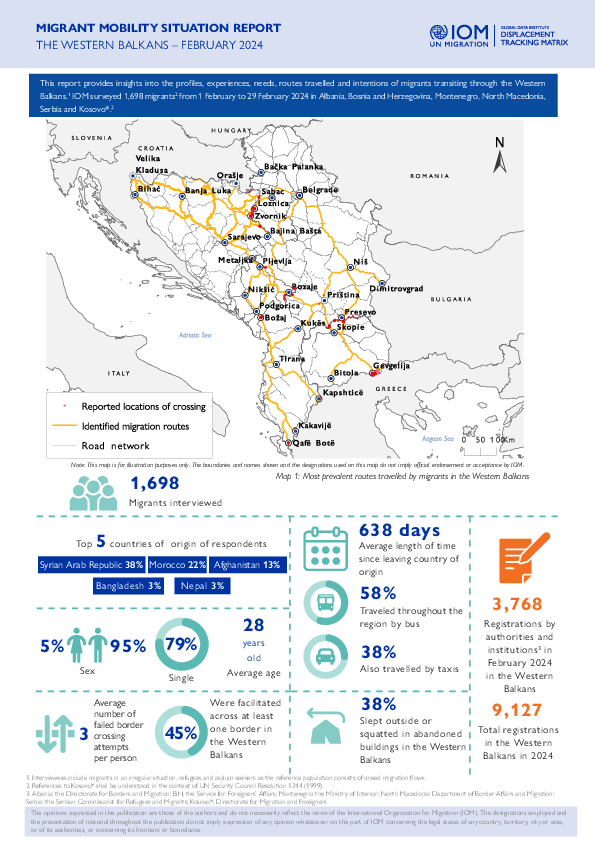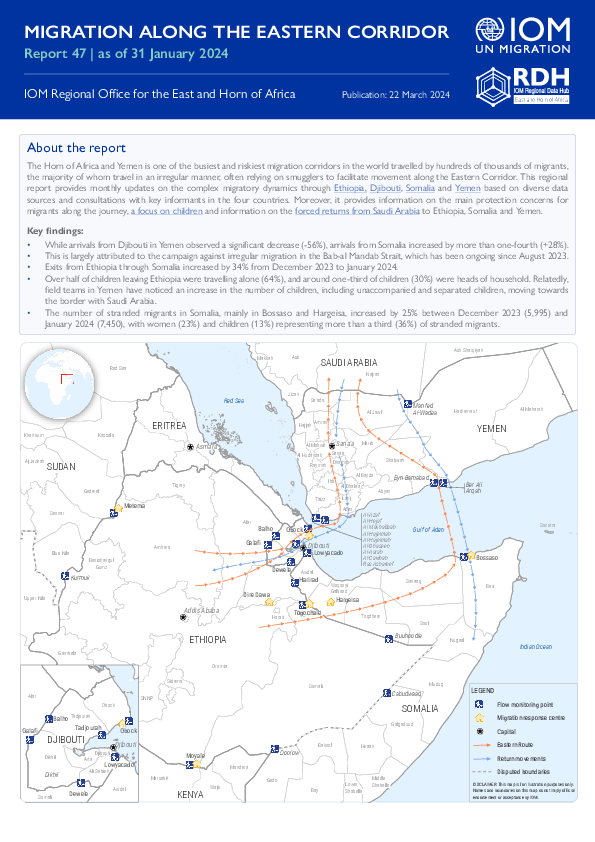-
Countries
-
Data and Analysis
-
Special Focus
-
Crisis Responses
This report provides insights into the profiles, experiences, needs, routes travelled and intentions of migrants transiting through the Western Balkans.
IOM surveyed 1,698 migrants from 1 February to 29 February 2024 in Albania, Bosnia and Herzegovina, Montenegro, North Macedonia, Serbia and Kosovo*.
* References to Kosovo* shall be understood in the context of UN Security Council Resolution 1244 (1999).

Contact
DTM Haiti, dtmhaiti@iom.int
Language
English
Location
Haiti
Period Covered
Mar 19 2024
Mar 22 2024
Activity
- Mobility Tracking
- Baseline Assessment
To continually inform humanitarian responses in the MAPAP sites, the CCCM cluster and DTM conduct weekly data collections in these sites to update information on the displacement situation in the sites.
This report presents the situation as of 22 March 2024. A total of 86 sites are active in the MAPAP hosting 88,743 IDPs, this represents 3% more compared to the previous week.

Contact
DTMMozambique@iom.int
Language
English
Location
Mozambique
Period Covered
Feb 08 2024
Mar 22 2024
Activity
- Mobility Tracking
- Event Tracking
Between 08 February and 22 March 2024, sporadic attacks and fear of attacks by Non-state Armed Groups in Quissanga and Ibo triggered the cumulative displacement of 465 individuals (corresponding to 189 families). [For more see Mozambique - Event Tracking Tool Dashboard].
Mar 22 2024
Print
This survey was administered in person with returnee heads of household in South Sudan to understand their plans for and potential concerns about (re)integration in their intended destinations in South Sudan.
Countries in this response
- Active DTM operation
- Past DTM operation

Contact
DTM Pakistan, DTMPakistan@iom.int
Language
English
Location
Pakistan
Period Covered
Mar 01 2024
Mar 15 2024
Activity
- Flow Monitoring
On 26 September 2023, the Ministry of Interior in Pakistan announced its decision to enact its “Illegal Foreigners’ Repatriation Plan (IFRP)”. Between 1 and 15 March 2024, 9,423 Afghan nationals returned to Afghanistan, including 6,737 through the Torkham BCP, 2,093 through the Chaman BCP, 593 through the Ghulam Khan BCP, while no Afghan nationals returned through the Badini BCP. In addition, border authorities deported 108 individuals due to a lack of valid documentation. Since 1 January 2024, IOM identified 46,621 returns at the four BCPs.
Contact
ISSDTM@iom.int
Location
South Sudan
Activity
- Survey
- Community Perception
Period Covered
Mar 07 2024 -Mar 14 2024
This survey focuses on South Sudanese returnees from Sudan who received onward transportation assistance from the International Organization for Migration (IOM) in coordination with the government of South Sudan. It was conducted over the phone with individuals who stated their destination as one of the four most common states of return for South Sudanese returnees: Upper Nile, Unity, Central Equatoria, and Northern Bahr el Ghazal.
Population Groups
Returnee (Previously Displaced Abroad)
Survey Methodology
Unit of Analysis Or Observation
Admin Area 2
Admin Area 3
Household
Type of Survey or Assessment
Household
Keywords
Geographical Scope Partial Coverage
Administrative boundaries with available data
The current dataset covers the following administrative boundaries
Since October 8 there has been an increase in cross-border incidents between Israel and Lebanon, resulting in the displacement of people both within the South and elsewhere within the country. Since October 10, the Displacement Tracking Matrix (DTM) has been conducting the daily monitoring of population movements. The objective of the exercise is to inform preparedness and response planning.
Population Groups
IDPs
Survey Methodology
Unit of Analysis Or Observation
Admin Area 2
Admin Area 3
Household
Individual
Type of Survey or Assessment
Key Informant
Keywords
Geographical Scope Full Coverage
Administrative boundaries with available data
The current dataset covers the following administrative boundaries

Contact
DTM South Sudan, SouthSudanDTM@iom.int
Language
English
Location
South Sudan
Period Covered
Sep 01 2023
Oct 19 2023
Activity
- Mobility Tracking
- Site Assessment
Between 1 September and 13 October 2023, the IOM's Displacement Tracking Matrix (DTM) carried out a Village Assessment Survey (VAS) in Juba County, Central Equatoria, with the goal of aiding planning for transition and recovery programs by mapping the availability of basic needs, services and infrastructure. The VAS data collection completed in sixteen payams and forty-nine bomas within Juba County. However, forty-one bomas were not assessed due to various factors including the lack of boma chief administrations, insecurity related to land grabbing (in Jebel Lodu and Tendere bomas), poor road conditions (in Kansuk boma), insecurity along a specific road (in Wonduruba payam), and discrepancies in boma names (in Mogiri). Additionally, some areas were not covered because residents had moved due to conflicts between farmers and cattle keepers, and one boma remained unassessed as it is currently having presence of soldiers.
Contact
Location
South Sudan
Activity
- Mobility Tracking
- Village Assessment
Period Covered
Sep 01 2023 -Oct 19 2023
Between 1 September and 13 October 2023, the IOM's Displacement Tracking Matrix (DTM) carried out a Village Assessment Survey (VAS) in Juba County, Central Equatoria, with the goal of aiding planning for transition and recovery programs by mapping the availability of basic needs, services and infrastructure. The VAS data collection completed in sixteen payams and forty-nine bomas within Juba County. However, forty-one bomas were not assessed due to various factors including the lack of boma chief administrations, insecurity related to land grabbing (in Jebel Lodu and Tendere bomas), poor road conditions (in Kansuk boma), insecurity along a specific road (in Wonduruba payam), and discrepancies in boma names (in Mogiri). Additionally, some areas were not covered because residents had moved due to conflicts between farmers and cattle keepers, and one boma remained unassessed as it is currently having presence of soldiers.
Population Groups
Survey Methodology
Unit of Analysis Or Observation
Community
Individual
Type of Survey or Assessment
Key Informant
Keywords
Geographical Scope Full Coverage
Administrative boundaries with available data
The current dataset covers the following administrative boundaries
Key finding in the Migration Along the Eastern Corridor in January 2024:
• While arrivals from Djibouti in Yemen observed a significant decrease (-56%), arrivals from Somalia increased by more than one-fourth (+28%).
• This is largely attributed to the campaign against irregular migration in the Bab-al Mandab Strait, which has been ongoing since August 2023.
• Exits from Ethiopia through Somalia increased by 34% from December 2023 to January 2024.
• Over half of the children leaving Ethiopia were travelling alone (64%), and around one-third of children (30%) were heads of household. Relatedly, field teams in Yemen have noticed an increase in the number of children, including unaccompanied and separated children, moving towards the border with Saudi Arabia.
• The number of stranded migrants in Somalia, mainly in Bossaso and Hargeisa, increased by 25% between December 2023 (5,995) and January 2024 (7,450), with women (23%) and children (13%) representing more than a third (36%) of stranded migrants.


